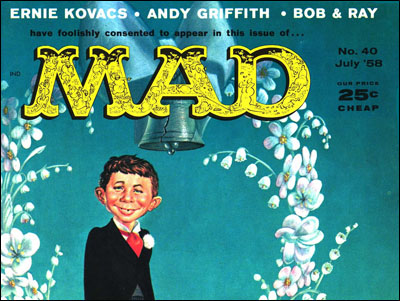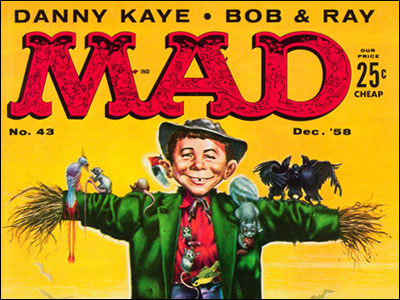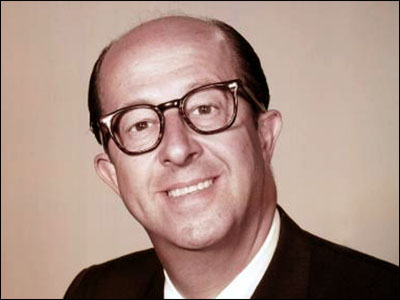
Kamden Spies wrote to ask…
You are one of the foremost experts on MAD Magazine. Do you know if there is any story behind the celebrity introductions of the first three MAD paperbacks? Why did MAD seek out Roger Price, Bob & Ray, and Stan Freberg to do them? Was it to improve sales or prestige? Also, was there a specific reason why they stopped doing them after the third one? Also since you were close to Stan Freberg, did Stan ever discuss with you how he got involved writing the introduction to Inside MAD?
You named the reason they did this: To improve sales or prestige, probably both. Harvey Kurtzman and Al Feldstein were very different men and they approached their respective editorships of MAD with different attitudes and very different skill sets. But they shared one premise: Both wanted to get MAD (and themselves) out of what was then seen as a comic book ghetto. The logo of EC Comics never appeared on MAD, nor did anything else that would tip off that that publication was from the same people who gave the world Tales From the Crypt comic books.
The difference between a magazine and a comic book may not seem that significant now but back then, there was a huge difference between the way the two forms were distributed, displayed and regarded. Both Kurtzman and Feldstein told me that they were embarrassed when they met people to say, "I do comic books." Saying "I edit a magazine" was so much better. And one of the ways you elevated the level of what you were doing — and it could only help sales, they thought — was to tie themselves and the magazine to folks like Bob & Ray or Stan Freberg who were well-known and not plying their trades in a ghetto.
Kurtzman wanted famous, respected people to be associated with his magazine. Publisher William Gaines said fine…reportedly, "As long as it doesn't cost much." In MAD's first magazine issue (#24), Kurtzman arranged to have material ostensibly by Ernie Kovacs, Roger Price and a few other humorists from the outside world. Price may not be well-remembered today but books of his Droodles cartoons were then pretty popular and he was appearing on a lot of TV panel shows and talk shows. Kurtzman (oddly) didn't advertise them on the cover but he listed them inside as if they were members of the magazine's staff. He did the same in #25 with Steve Allen, Doodles Weaver and Stan Freberg, and also billed Al Jaffee as if he were a celebrity of equal import.
Not long after this, Freberg wrote the foreword — which appeared at the end of the book and was billed as a "backword" — for the Inside MAD paperback. Stan said he was approached and a very low fee was offered but he liked the idea of helping out a new humor magazine and thought maybe some MAD readers would be moved to seek out his records. As he recalled, it was all by mail and phone so he never met Kurtzman in person.
In #26, Kurtzman again had material allegedly (though with his permission) by Kovacs and some work by Price. In #27, he had a song by Abe Burrows, complete with sheet music illustrated by Russ Heath. Again, Burrows was something of a celebrity then on panel and talk shows, plus #27 also had pieces by Freberg and Price. In #28, he didn't have anyone known from TV and then #29 was a transition issue. Feldstein was listed as editor but a majority of the pieces (including an Ernie Kovacs one) were obviously Kurtzman leftovers.
Material that was at least started by Kurtzman appeared in the next few issues amidst new stuff Feldstein was buying. There were Kurtzman articles in #30, including a photo feature with Carl Reiner. In #31, the Kurtzman material included pieces credited to Kovacs, comedian Orson Bean and Al "Jazzbo" Collins. Collins was a then-popular disc jockey who briefly hosted a strange version of The Tonight Show — it was called Tonight: America After Dark — between the stints of Steve Allen and Jack Paar. But Feldstein and probably Gaines did something with the "celebrity" names on #31 that Kurtzman had never done: The names were advertised on the cover.
In #32, there was a song by Tom Lehrer illustrated by George Woodbridge. Woodbridge was a Feldstein hire so at least the art, if not the arrangements with Lehrer or his reps, were post-Kurtzman. There was also another Orson Bean piece and one by humorist Jean Shepherd. The relationship with Bean seems to have been started by Kurtzman and continued by Feldstein, whereas Feldstein told me he inherited the Jean Shepherd article.
#33 featured what I believe was the last of the Kurtzman remnants but I don't think he was involved in any of the "celeb" pieces in it. The billed-as-by-Ernie-Kovacs article was the first of several pages illustrated by Wally Wood called "Strangely Believe It" parodying the newspaper feature, Ripley's Believe It Or Not. There were also adaptations of material by Henry Morgan and Eddie "The Old Philosopher" Lawrence.

In #34, MAD cover-billed Orson Bean and two guys who'd be in a lot of issues for a while, Bob & Ray. The Bob & Ray articles were adapted from material they or their main writer, Tom Koch, had written for their popular radio program. Koch soon became a regular freelancer writing non-Bob & Ray material for MAD for many years but the real interesting thing about those pieces had to do with who Feldstein assigned to draw them.
He'd had to add a lot of artists to the MAD talent pool to replace the ones that had left with Kurtzman. One he added was a guy who'd been mainly drawing comic books for DC and occasionally other companies. The artist initially balked at the assignment because it would call for him to draw Bob Elliott and Ray Goulding in almost every panel and he'd had little experience drawing likenesses of real people. But Feldstein and a MAD staffer named Nick Meglin urged him to try and the artist tackled the job and succeeded. In fact, he got pretty good at drawing famous people. His name was Mort Drucker.
On #35, no one got billing on the cover but #36 had Wally Cox, Henry Morgan and Bob & Ray. On #37, it was Kovacs, Bean and Bob & Ray. On #38, it was Kovacs, Bob & Ray and the cover artist. The cover was a finger painting by J. Fred Muggs, a trained chimpanzee who, Strangely Believe It, was a regular on NBC's Today Show.

On #39, nobody made the cover but inside, there was another Bob & Ray piece. On #40, it was Kovacs, Andy Griffith and Bob & Ray. On #41, you got Kovacs, Morgan and Bob & Ray. On #42, it was Kovacs, Danny Kaye and Bob & Ray. On #43, it was Kaye and Bob & Ray. On #44, no celebs made the cover but Bob & Ray were inside. #45 and #46 were devoid of famous names on the cover or inside. #47 offered Sid Caesar and Bob & Ray. #48 and #49 had Sid Caesar and then Mr. Caesar reappeared on #55…and that was the end of famous names on the cover of MAD until (I think) June of 2015 when they cover-featured the participation of "Weird Al" Yankovic in the issue.
Feldstein and Gaines had looked at the sales figures on the issues which had celebrity contributors advertised versus those that didn't and concluded that MAD no longer needed them. It wasn't worth the hassle of dealing with agents and publicists and whoever arranged for someone famous to write something for MAD or, far more often, allow something of theirs to be adapted and credited to them. I suspect they'd realized that earlier with the paperback books which is why they'd stopped having forewords by famous folks. And I'm sorry. I know this is a lot longer an answer than you expected, Kamden, but I sometimes get carried away…or should be.








